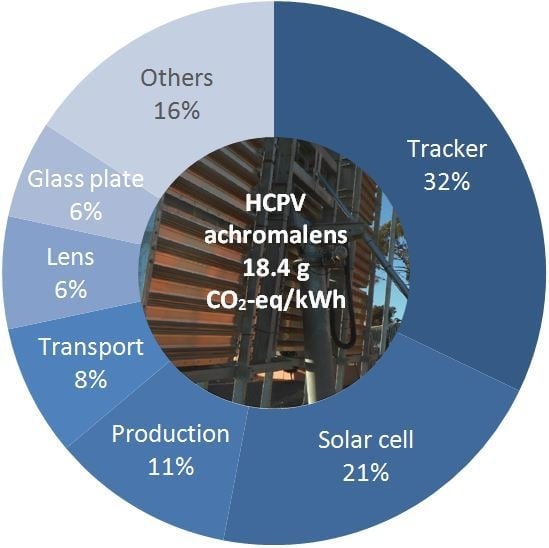Life Cycle Assessment of New High Concentration Photovoltaic (HCPV) Modules and Multi-Junction Cells
Abstract
1. Introduction
2. High Concentration Photovoltaic Technologies
3. Methods
3.1. Research Methodology
3.2. Life Cycle Assessment Presentation
4. Scope and Goal Definition
4.1. Function and Functional Unit
4.2. The Three Different Scenarios Under Study
4.3. System Boundaries
4.4. Modeling Assumptions
5. Life Cycle Inventory Analysis
5.1. Material Manufacturing and Assembling
5.2. Transportation and Factory
5.3. Use Phase
5.4. End-Of-Life and Final Disposal
6. Results
6.1. Electricity Generation Over its Entire Lifespan
6.2. Climate Change
6.3. Particulate Matter
6.4. Land Use
6.5. Aquatic Biodiversity
6.6. Single Score Results
7. Discussion
7.1. Discussing How Key Environmental Parameters Affect the Results
7.2. Important Aspect and Sensitivity Analysis Related to Impact Assessment Models
7.3. Comparing Environmental Performances of HCPV with Other Energy Sources
7.4. Exploring the Possible Interest of HCPV Modules in a Circular Economy Perspective
8. Conclusions
Supplementary Materials
Author Contributions
Funding
Conflicts of Interest
Glossary
| Alloc Def | Allocation default |
| BIPV | Building Integrated Photovoltaics |
| EPBT | Energy Payback Time |
| EVA | Ethylene vinyl acetate |
| CH | Switzerland |
| CN | China |
| CPBT | Carbon Payback Time |
| CPV | Concentrated photovoltaics |
| EOL | End-Of-Life |
| FJCs | Four-junction cells |
| Ge | Germanium |
| GLO | World |
| HCPV | High concentrated photovoltaics |
| IEA | International Energy Agency |
| ILCD | International Reference for Life Cycle Data system |
| kWh | Kilo-Watt per hour |
| kWp | Kilo-Watt peak |
| LCA | Life Cycle Assessment |
| LCI | Life Cycle Inventory |
| LCIA | Life Cycle impact Assessment |
| MA | Morocco |
| MJprim | Megajoule primary |
| PEF | Product Environmental Footprint |
| RER | Europe |
| RoW | Rest of World |
| U | Unit process |
| US | United States of America |
Appendix A
| EcoInvent 3.3 Process | 2007 | 2016 |
|---|---|---|
| Electricity, hard coal, at power plant/CN U | 41.2% | 38.3% |
| Electricity, oil, at power plant/FR U | 5.5% | 3.7% |
| Electricity, natural gas, at power plant/US U | 21.2% | 23.1% |
| Electricity, low voltage {CH}| treatment of biogas, burned in micro gas turbine 100 kWe | Alloc Def, U | 1.0% | 1.8% |
| Electricity, production mix photovoltaic, at plant/CH U | 0.01% | 1.3% |
| Electricity, at wind power plant 800 kW/RER U | 0.9% | 3.8% |
| Electricity from waste, at municipal waste incineration plant/CH U | 0.3% | 0.4% |
| Electricity, nuclear, at power plant/CH U | 13.7% | 10.4% |
| Electricity, hydropower, at power plant/FR U | 15.9% | 16.7% |
| Electricity, high voltage {RoW}| electricity production, geothermal | Alloc Def, U | 0.3% | 0.3% |
| EcoInvent 3.3 Process | 2007 | 2012 | 2016 |
|---|---|---|---|
| Hard coal, burned in power plant/CN U | 27.5% | 29.0% | 27.1% |
| Heavy fuel oil, burned in power plant/FR U | 33.7% | 31.7% | 31.9% |
| Natural gas, burned in power plant/US U | 20.8% | 21.4% | 22.1% |
| Electricity, low voltage {CH}| treatment of biogas, burned in micro gas turbine 100 kWe | Alloc Def, U | 9.4% | 9.5% | 9.8% |
| Electricity, nuclear, at power plant/CH U | 5.8% | 4.8% | 4.9% |
| Electricity, hydropower, at power plant/FR U | 2.2% | 2.4% | 2.5% |
| Electricity, high voltage {RoW}| electricity production, geothermal | Alloc Def, U | 0.7% | 1.1% | 1.6% |
| EcoInvent 3.3 Process | Repartition |
|---|---|
| Hard coal, burned in power plant/CN U | 12.1% |
| Heavy fuel oil, burned in power plant/FR U | 39.8% |
| Natural gas, burned in power plant/US U | 15.1% |
| Electricity, low voltage {CH}| treatment of biogas, burned in micro gas turbine 100 kWe | Alloc Def, U | 11.3% |
| Electricity, production mix photovoltaic, at plant/CH U | 0.3% |
| Other processes | |
| Electricity | 17.9% |
| Heat | 3.2% |
Appendix B
| Category | Unit | Mirror | Fresnel Lens | Achromalens |
|---|---|---|---|---|
| Climate change | g CO2-eq | 16.4 | 17.1 | 18.4 |
| Ozone depletion | µg CFC-11-eq | 1.69 | 2.01 | 2.06 |
| Human toxicity, non-cancer effects | CTUh | 3.59 × 10−8 | 4.85 × 10−8 | 4.87 × 10−8 |
| Human toxicity, cancer effects | CTUh | 2.46 × 10−9 | 2.88 × 10−9 | 2.92 × 10−9 |
| Particulate matter | mg PM2.5-eq | 11.9 | 11.6 | 12.5 |
| Ionizing radiation HH | Bq U235-eq | 3.51 | 5.05 | 5.13 |
| Ionizing radiation E (interim) | CTUe | 8.49 × 10−9 | 1.10 × 10−8 | 1.12 × 10−8 |
| Photochemical ozone formation | mg NMVOC-eq | 55.0 | 62.1 | 65.0 |
| Acidification | mmolc H+-eq | 1.16 × 10−1 | 1.31 × 10−1 | 1.36 × 10−1 |
| Terrestrial eutrophication | mmolc N-eq | 1.90 × 10−1 | 2.22 × 10−1 | 2.31 × 10−1 |
| Freshwater eutrophication | mg P-eq | 22.1 | 30.4 | 30.5 |
| Marine eutrophication | mg N-eq | 57.5 | 86.3 | 88.0 |
| Freshwater ecotoxicity | CTUe | 2.68 | 3.10 | 3.11 |
| Land use | g C deficit | 1.31 × 102 | 1.46 × 102 | 1.47 × 102 |
| Water resource depletion | mL wate-eq | 44.8 | 1.05 × 102 | 1.06 × 102 |
| Mineral, fossil & ren resource depletion | g Sb-eq | 3.57 | 16.3 | 16.3 |
| Component | Life Cycle Span (Years) |
|---|---|
| Two-axis tracker | 30 |
| HCPV module | 30 |
| Cables | 30 |
| Manufacturing plant | 30 |
| Inverter | 15 |
| Transformer | 10 |
References
- IEA. IEA Website. Available online: https://www.iea.org/statistics/ (accessed on 10 March 2019).
- Landrigan, P.J.; Fuller, R.; Acosta, N.J.R.; Adeyi, O.; Arnold, R.; Basu, N.N.; Baldé, A.B.; Bertollini, R.; Bose-O’Reilly, S.; Boufford, J.I.; et al. The Lancet Commission on pollution and health. Lancet 2018, 391, 462–512. [Google Scholar] [CrossRef]
- MacKay, D.J.C. Solar energy in the context of energy use, energy transportation and energy storage. Philos. Trans. R. Soc. A Math. Phys. Eng. Sci. 2013, 371. [Google Scholar] [CrossRef] [PubMed]
- Capellán-Pérez, I.; de Castro, C.; Arto, I. Assessing vulnerabilities and limits in the transition to renewable energies: Land requirements under 100% solar energy scenarios. Renew. Sustain. Energy Rev. 2017, 77, 760–782. [Google Scholar] [CrossRef]
- Broswimmer, F.; Écocide, L. Une brève histoire de l’extinction en masse des espèces; Paragon: Paris, France, 2003. [Google Scholar]
- Novacek, M. Terra: Our 100-Million-Year-Old Ecosystem--and the Threats That Now Put It at Risk; Farrar, Straus and Giroux: New York, NY, USA, 2008. [Google Scholar]
- Rosenbaum, R.K.; Bachmann, T.M.; Gold, L.S.; Huijbregts, M.A.J.; Jolliet, O.; Juraske, R.; Koehler, A.; Larsen, H.F.; MacLeod, M.; Margni, M.; et al. USEtox - The UNEP-SETAC toxicity model: Recommended characterisation factors for human toxicity and freshwater ecotoxicity in life cycle impact assessment. Int. J. Life Cycle Assess. 2008, 13, 532–546. [Google Scholar] [CrossRef]
- Henderson, A.D.; Hauschild, M.Z.; Van De Meent, D.; Huijbregts, M.A.J.; Larsen, H.F.; Margni, M.; McKone, T.E.; Payet, J.; Rosenbaum, R.K.; Jolliet, O. USEtox fate and ecotoxicity factors for comparative assessment of toxic emissions in life cycle analysis: Sensitivity to key chemical properties. Int. J. Life Cycle Assess. 2011, 16, 701–709. [Google Scholar] [CrossRef]
- Pennington, D.W.; Payet, J.; Hauschild, M. Aquatic ecotoxicological indicators in life-cycle assessment. Environ. Toxicol. Chem. 2004, 23, 1796–1807. [Google Scholar] [CrossRef]
- Struijs, J.; Beusen, A.; van Jaarsveld, H.; Huijbregts, M.A.J. Aquatic Eutrophication. Chapter 6. In ReCiPe 2008—A Life Cycle Impact Assessment Method Which Comprises Harmonised Category Indicators at the Midpoint and the Endpoint Level, 1st ed.; Report I: Characterisation Factors; Goedkoop, M., Heijungs, R., Huijbregts, M.A.J., De Schryver, A., Struijs, J., Van Zelm, R., Eds.; VROM: Barendrecht, The Netherlands, 2009. [Google Scholar]
- Seppälä, J.; Posch, M.; Johansson, M.; Hettelingh, J.P. Country-dependent characterisation factors for acidification and terrestrial eutrophication based on accumulated exceedance as an impact category indicator. Int. J. Life Cycle Assess. 2006, 11, 403–416. [Google Scholar] [CrossRef]
- Posch, M.; Seppälä, J.; Hettelingh, J.P.; Johansson, M.; Margni, M.; Jolliet, O. The role of atmospheric dispersion models and ecosystem sensitivity in the determination of characterisation factors for acidifying and eutrophying emissions in LCIA. Int. J. Life Cycle Assess. 2008, 13, 477–486. [Google Scholar] [CrossRef]
- Payet, J. Assessing toxic impacts on aquatic ecosystems in LCA. Int. J. Life Cycle Assess. 2005, 10, 373. [Google Scholar] [CrossRef]
- Pang, M.; Zhang, L.; Wang, C.; Liu, G. Environmental life cycle assessment of a small hydropower plant in China. Int. J. Life Cycle Assess. 2015, 20, 796–806. [Google Scholar] [CrossRef]
- Flury, K.; Frischknecht, R. Life Cycle Inventories of Hydroelectric Power Generation; ESU-services Ltd.: Kanzleistrasse, Switzerland, 2012. [Google Scholar]
- Guezuraga, B.; Zauner, R.; Pölz, W. Life cycle assessment of two different 2 MW class wind turbines. Renew. Energy 2012, 37, 37–44. [Google Scholar] [CrossRef]
- Crago, C.L.; Koegler, E. Drivers of growth in commercial-scale solar PV capacity. Energy Policy 2018, 120, 481–491. [Google Scholar] [CrossRef]
- Masson, G.; Orlandi, S.; Rekinger, M. Global Market Outlook for Photovoltaics 2013-2017; Solar Power Europe: Brussels, Belgium, 2013. [Google Scholar]
- Uwe, F.; Göran, B.; Annette, C.; Francis, J.; Virginia, D.; Hans, L.; Navin, S.; Helen, W.; Jeremy, W. Energy and Land Use—Global Land Outlook Working Paper; UNCCD: Bonn, Germany, 2017. [Google Scholar] [CrossRef]
- Hernandez, R.R.; Hoffacker, M.K.; Murphy-Mariscal, M.L.; Wu, G.C.; Allen, M.F. Solar energy development impacts on land cover change and protected areas. Proc. Natl. Acad. Sci. USA 2015, 112, 13579–13584. [Google Scholar] [CrossRef] [PubMed]
- Hoffacker, M.K.; Allen, M.F.; Hernandez, R.R. Land-Sparing Opportunities for Solar Energy Development in Agricultural Landscapes: A Case Study of the Great Central Valley, CA, United States. Environ. Sci. Technol. 2017, 51, 14472–14482. [Google Scholar] [CrossRef] [PubMed]
- Piemonte, V.; De Falco, M.; Tarquini, P.; Giaconia, A. Life Cycle Assessment of a high temperature molten salt concentrated solar power plant. Sol. Energy 2011, 85, 1101–1108. [Google Scholar] [CrossRef]
- Renno, C. Experimental and theoretical analysis of a linear focus CPV/T system for cogeneration purposes. Energies 2018, 11, 2960. [Google Scholar] [CrossRef]
- Gomaa, M.R.; Mustafa, R.J.; Rezk, H.; Al-Dhaifallah, M.; Al-Salaymeh, A. Sizing methodology of a multi-mirror solar concentrated hybrid PV/thermal system. Energies 2018, 11, 3276. [Google Scholar] [CrossRef]
- Vallerotto, G.; Victoria, M.; Askins, S.; Antón, I.; Sala, G. Improvements in the manufacturing process of achromatic doublet on glass (ADG) Fresnel lens. In AIP Conference Proceedings; AIP Publishing: Melville, NY, USA, 2018. [Google Scholar] [CrossRef]
- Vallerotto, G.; Victoria, M.; Askins, S.; Herrero, R.; Domínguez, C.; Antón, I.; Sala, G. Design and modeling of a cost-effective achromatic Fresnel lens for concentrating photovoltaics. Opt. Express 2016, 24, A1245. [Google Scholar] [CrossRef] [PubMed]
- Dimroth, F.; Tibbits, T.N.D.; Niemeyer, M.; Predan, F.; Beutel, P.; Karcher, C.; Oliva, E.; Siefer, G.; Lackner, D.; Fuß-kailuweit, P.; et al. Four-Junction Wafer-Bonded Concentrator Solar Cells. IEEE J. Photovolt. 2015, 6, 343–349. [Google Scholar] [CrossRef]
- Corona, B.; Escudero, L.; Quéméré, G.; Luque-Heredia, I.; San Miguel, G. Energy and environmental life cycle assessment of a high concentration photovoltaic power plant in Morocco. Int. J. Life Cycle Assess. 2017, 22, 364–373. [Google Scholar] [CrossRef]
- RSE. Results of the APOLLON Project and Concentrating Photovoltaic Perspective; Ricerca sul Sistema Energetico—RSE S.p.A.: Milan, Italy, 2014. [Google Scholar]
- Scholten, M.D.W.; Cassagne, V.; Huld, T. Solar Resources and Carbon Footprint of Photovoltaic Power in Different Regions in Europe. In Proceedings of the 29th European PV Solar Energy Conference, Amsterdam, The Netherlands, 22–26 September 2014; pp. 3421–3430. [Google Scholar]
- Fthenakis, V.M.; Kim, H.C. Life cycle assessment of high-concentration photovoltaic systems. Prog. Photovolt. Res. Appl. 2009, 17, 11–33. [Google Scholar] [CrossRef]
- Kim, H.C.; Fthenakis, V.M. Life cycle energy demand and greenhouse gas emissions from an amonix high concentrator photovoltaic system. In Proceedings of the 2006 IEEE 4th World Conference on Photovoltaic Energy Conference, Waikoloa, HI, USA, 7–12 May 2006; pp. 628–631. [Google Scholar]
- Matzer, R.; Peharz, G.; Patyk, A.; Dimroth, F.; Bett, A.W. Life cycle assessment of the concentrating photovoltaic system FLATCON. In Advances in Energy Studies 2008: Towards an Holistic Approach Based on Science and Humanity; Workshop: Graz, Austria, 2008. [Google Scholar]
- Agustín-Sáenz, C.; Sánchez-García, J.Á.; Machado, M.; Brizuela, M.; Zubillaga, O.; Tercjak, A. Broadband antireflective coating stack based on mesoporous silica by acid-catalyzed sol-gel method for concentrated photovoltaic application. Sol. Energy Mater. Sol. Cells 2018, 186, 154–164. [Google Scholar] [CrossRef]
- Alonso, R.; Pereda, A.; Bilbao, E.; Cortajarena, J.A.; Vidaurrazaga, I.; Román, E. Design and analysis of performance of a DC power optimizer for HCPV systems within CPVMatch project. AIP Conf. Proc. 2018, 2012, 050001. [Google Scholar]
- Van Riesen, S.; Neubauer, M.; Boos, A.; Rico, M.M.; Gourdel, C.; Wanka, S.; Krause, R.; Guernard, P.; Gombert, A. New module design with 4-junction solar cells for high efficiencies. In Proceedings of the 11th International Conference on Concentrator Photovoltaic Systems (CPV-11), AIP Conference Proceedings 1679, Aix-les-Bains, France, 13–15 April 2015; p. 100006. [Google Scholar]
- European Commission Eurostat. Available online: http://ec.europa.eu/eurostat/statistics-explained/index.php/Electricity_production,_consumption_and_market_overview/fr (accessed on 10 February 2019).
- Payet, J.; Evon, B.; Sié, M.; Blanc, I.; Beloin-Saint-Pierre, D.; Adra, N.; Raison, E.; Puech, C.; Durand, Y. Référentiel d’évaluation des Impacts Environnementaux des Systèmes Photovoltaïques par la Méthode D’analyse du Cycle de Vie; Cycleco: Ambérieu-en-Bugey, France, 2011. [Google Scholar]
- Jolliet, O.; Soucy, G.; Houillon, G. Analyse du cycle de vie: comprendre et réaliser un écobilan, 3rd ed.; Presses Polytechniques et Universitaires Romandes: Lausanne, Switzerland, 2010; ISBN 2880748860. [Google Scholar]
- ISO 14040. Environmental Management—Life Cycle Assessment—Principles and Framework; ISO: Geneva, Switzerland, 2006. [Google Scholar]
- ISO 14044. Gestion environnementale—Analyse du Cycle de vie— Exigences et Lignes Directrices; ISO: Geneva, Switzerland, 2006. [Google Scholar]
- ILCD. European Commission—Joint Research Centre—Institute for Environment and Sustainability: International Reference Life Cycle Data System (ILCD) Handbook—General Guide for Life Cycle Assessment—Detailed Guidance, 1st ed.; EUR 24708 EN.; Publications Office of the European Union: Luxembourg, 2010. [Google Scholar]
- European Commission. PEFCR Guidance Document, Guidance for the 14 Development of Product Environmental Footprint Category Rules (PEFCRs); version 6.3; European Commission: Brussels, Belgium, 2017.
- De Haes, H.A.U.; Sleeswijk, A.W.; Heijungs, R. Similarities, differences and synergisms between HERA and LCA - An analysis at three levels. Hum. Ecol. Risk Assess. 2006, 12, 431–449. [Google Scholar] [CrossRef]
- Perpinan, O.; Lorenzo, E.; Castro, M.A.; Eyras, R. Energy Payback Time of Grid Connected PV Systems: Comparison Between Tracking and Fixed Systems. Prog. Photovolt. Res. Appl. 2009, 17, 137–147. [Google Scholar] [CrossRef]
- Alsema, E.A.; Wild-Scholten, M.J.d. Environmental impact of crystalline silicon photovoltaic module production. In Proceedings of the CIRP International Conference on Life Cycle Engineering, Leuven, Belgium, 31 May–2 June 2006. [Google Scholar]
- Constantino, G.; Freitas, M.; Fidelis, N.; Pereira, M.G. Adoption of photovoltaic systems along a sure path: A life-cycle assessment (LCA) study applied to the analysis of GHG emission impacts. Energies 2018, 11, 2806. [Google Scholar] [CrossRef]
- Nishimura, A.; Hayashi, Y.; Tanaka, K.; Hirota, M.; Kato, S.; Ito, M.; Araki, K.; Hu, E.J. Life cycle assessment and evaluation of energy payback time on high-concentration photovoltaic power generation system. Appl. Energy 2010, 87, 2797–2807. [Google Scholar] [CrossRef]
- Kommalapati, R.; Kadiyala, A.; Shahriar, M.T.; Huque, Z. Review of the life cycle greenhouse gas emissions from different photovoltaic and concentrating solar power electricity generation systems. Energies 2017, 10, 350. [Google Scholar] [CrossRef]
- Edenhofer, O.; Pichs-Madruga, R.; Sokona, Y.; Farahani, E.; Kadner, S.; Seyboth, K.; Adler, A.; Baum, I.; Brunner, S.; Eickemeier, P.; et al. (Eds.) Climate Change 2014: Mitigation of Climate Change; Contribution of Working Group III to the Fifth Assessment Report of the Intergovernmental Panel on Climate Change; Cambridge University Press: Cambridge, UK; New York, NY, USA, 2014. [Google Scholar]
- Rabl, A.; Spadaro, J.V. The RiskPoll Software, Version is 1.051. 2004. Available online: http://www.arirabl.com (accessed on 1 August 2004).
- Milà i Canals, L.; Romanyà, J.; Cowell, S.J. Method for assessing impacts on life support functions (LSF) related to the use of “fertile land” in Life Cycle Assessment (LCA). J. Clean. Prod. 2007, 15, 1426–1440. [Google Scholar] [CrossRef]
- Staudinger, J.; Keoleian, G.A.; Flynn, M.S. Management of End-of Life Vehicles (ELVs) in the US; University of Michigan: Washtenaw, MI, USA, 2001. [Google Scholar]
- Latunussa, C.E.L.; Ardente, F.; Blengini, G.A.; Mancini, L. Life Cycle Assessment of an innovative recycling process for crystalline silicon photovoltaic panels. Sol. Energy Mater. Sol. Cells 2016, 156, 101–111. [Google Scholar] [CrossRef]
- Rathod, K.; Gupta, S.; Sharma, A.; Prakash, S. Energy-Efficient Melting Technologies in Foundry Industry. Indian Foundry J. 2016, 62, 39–46. [Google Scholar]
- Šúri, M.; Huld, T.A.; Dunlop, E.D. PV-GIS: A web-based solar radiation database for the calculation of PV potential in Europe. Int. J. Sustain. Energy 2005, 24, 55–67. [Google Scholar] [CrossRef]
- Adibi, N.; Lafhaj, Z.; Gemechu, E.D.; Sonnemann, G.; Payet, J. Introducing a multi-criteria indicator to better evaluate impacts of rare earth materials production and consumption in life cycle assessment. J. Rare Earths 2014, 32, 288–292. [Google Scholar] [CrossRef]
- Adibi, N.; Lafhaj, Z.; Yehya, M.; Payet, J. Global Resource Indicator for life cycle impact assessment: Applied in wind turbine case study. J. Clean. Prod. 2017, 165, 1517–1528. [Google Scholar] [CrossRef]
- Adibi, N.; Lafhaj, Z.; Payet, J. New resource assessment characterization factors for rare earth elements: applied in NdFeB permanent magnet case study. Int. J. Life Cycle Assess. 2019, 24, 712–724. [Google Scholar] [CrossRef]
- Witik, R.A.; Payet, J.; Michaud, V.; Ludwig, C.; Månson, J.A.E. Assessing the life cycle costs and environmental performance of lightweight materials in automobile applications. Compos. Part A Appl. Sci. Manuf. 2011, 42, 1694–1709. [Google Scholar] [CrossRef]
- Jolliet, O.; Margni, M.; Charles, R.; Humbert, S.; Payet, J.; Rebitzer, G. IMPACT 2002+: A New Life Cycle Impact Assessment Methodology. Ind. Ecol. 2003, 8, 324–330. [Google Scholar] [CrossRef]
- Dong, Y.; Gandhi, N.; Hauschild, M.Z. Development of Comparative Toxicity Potentials of 14 cationic metals in freshwater. Chemosphere 2014, 112, 26–33. [Google Scholar] [CrossRef] [PubMed]
- Dong, Y.; Rosenbaum, R.K.; Hauschild, M.Z. Assessment of Metal Toxicity in Marine Ecosystems: Comparative Toxicity Potentials for Nine Cationic Metals in Coastal Seawater. Environ. Sci. Technol. 2016, 50, 269–278. [Google Scholar] [CrossRef] [PubMed]
- Haye, S.; Slaveykova, V.I.; Payet, J. Terrestrial ecotoxicity and effect factors of metals in life cycle assessment (LCA). Chemosphere 2007, 68, 1489–1496. [Google Scholar] [CrossRef] [PubMed]
- Zhang, Z.; Zhang, F.; Li, M.; Liu, L.; Liu, W.; Lv, H.; Liu, Y.; Yao, P.; Liu, W.; Ou, Q.; et al. Progress in agriculture photovoltaic leveraging CPV. AIP Conf. Proc. 2018, 2012, 110006. [Google Scholar]
- Hyder, F.; Baredar, P.; Sudhakar, K.; Mamat, R. Performance and land footprint analysis of a solar photovoltaic tree. J. Clean. Prod. 2018, 187, 432–448. [Google Scholar] [CrossRef]
- Poggi, F.; Firmino, A.; Amado, M. Planning renewable energy in rural areas: Impacts on occupation and land use. Energy 2018, 155, 630–640. [Google Scholar] [CrossRef]
- Mathieux, F.; Ardente, F.; Bobba, S.; Nuss, P.; Blengini, G.; Alves Dias, P.; Blagoeva, D.; Torres De Matos, C.; Wittmer, D.; Pavel, C.; et al. Critical Raw Materials and the Circular Economy—Background Report; JRC Science-for-Policy Report, EUR 28832 EN; Publications Office of the European Union: Luxembourg, 2017; ISBN 978-92-79-74282-8. [Google Scholar] [CrossRef]
- Van Oers, L.; de Koning, A.; Guinee, J.B.; Huppes, G. Abiotic Resource Depletion in LCA; Road and Hydraulic Engineering Institute, Ministry of Transport and Water: Amsterdam, The Netherlands, 2002. [Google Scholar]
- Wernet, G.; Bauer, C.; Steubing, B.; Reinhard, J.; Moreno-Ruiz, E.; Weidema, B. The ecoinvent database version 3 (part I): overview and methodology. Int. J. Life Cycle Assess. 2016, 21, 1218–1230. [Google Scholar] [CrossRef]
- Geldron, A. Economie Circulaire: Notions; ADEME: Vonges, France, 2014; pp. 1–9. [Google Scholar]
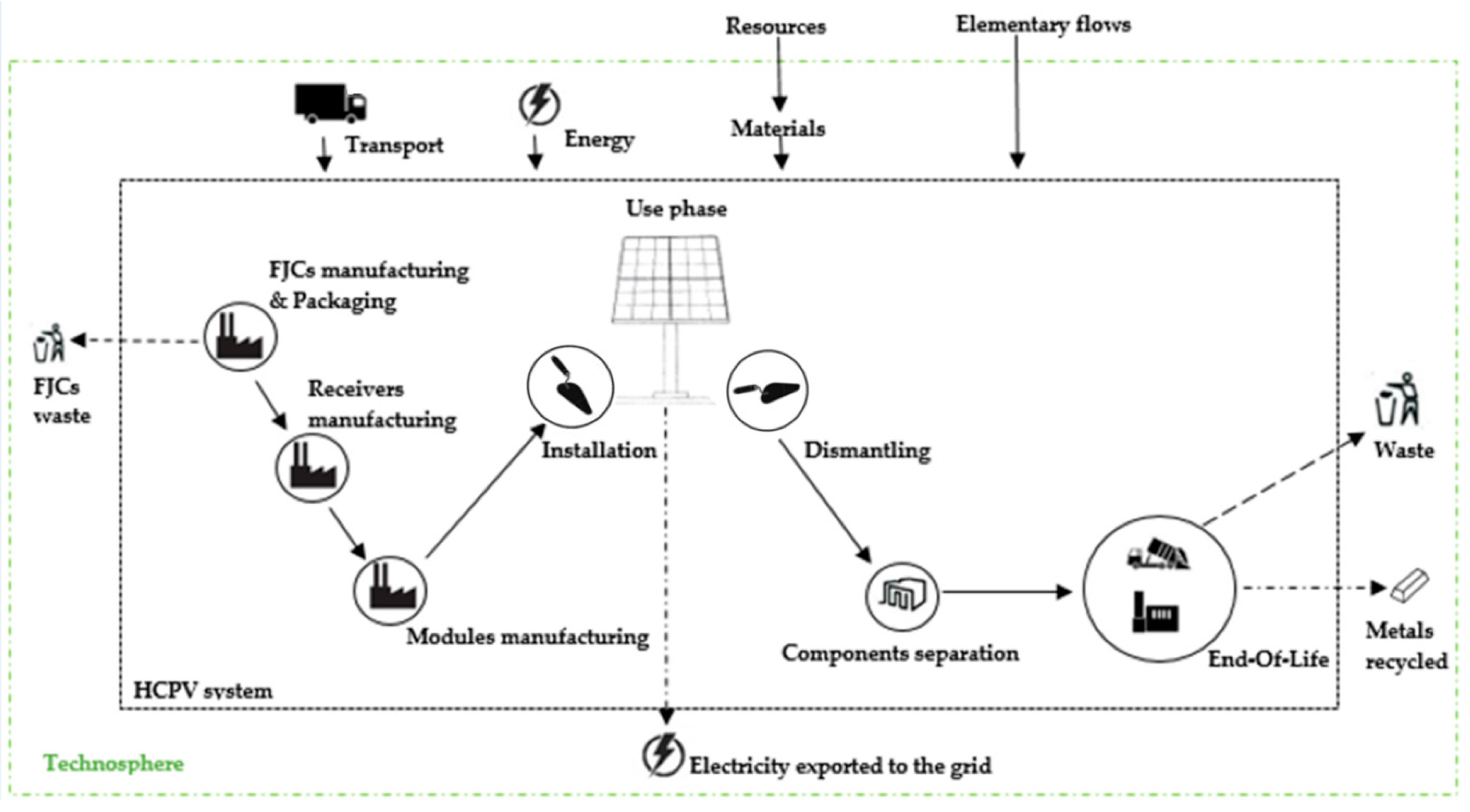
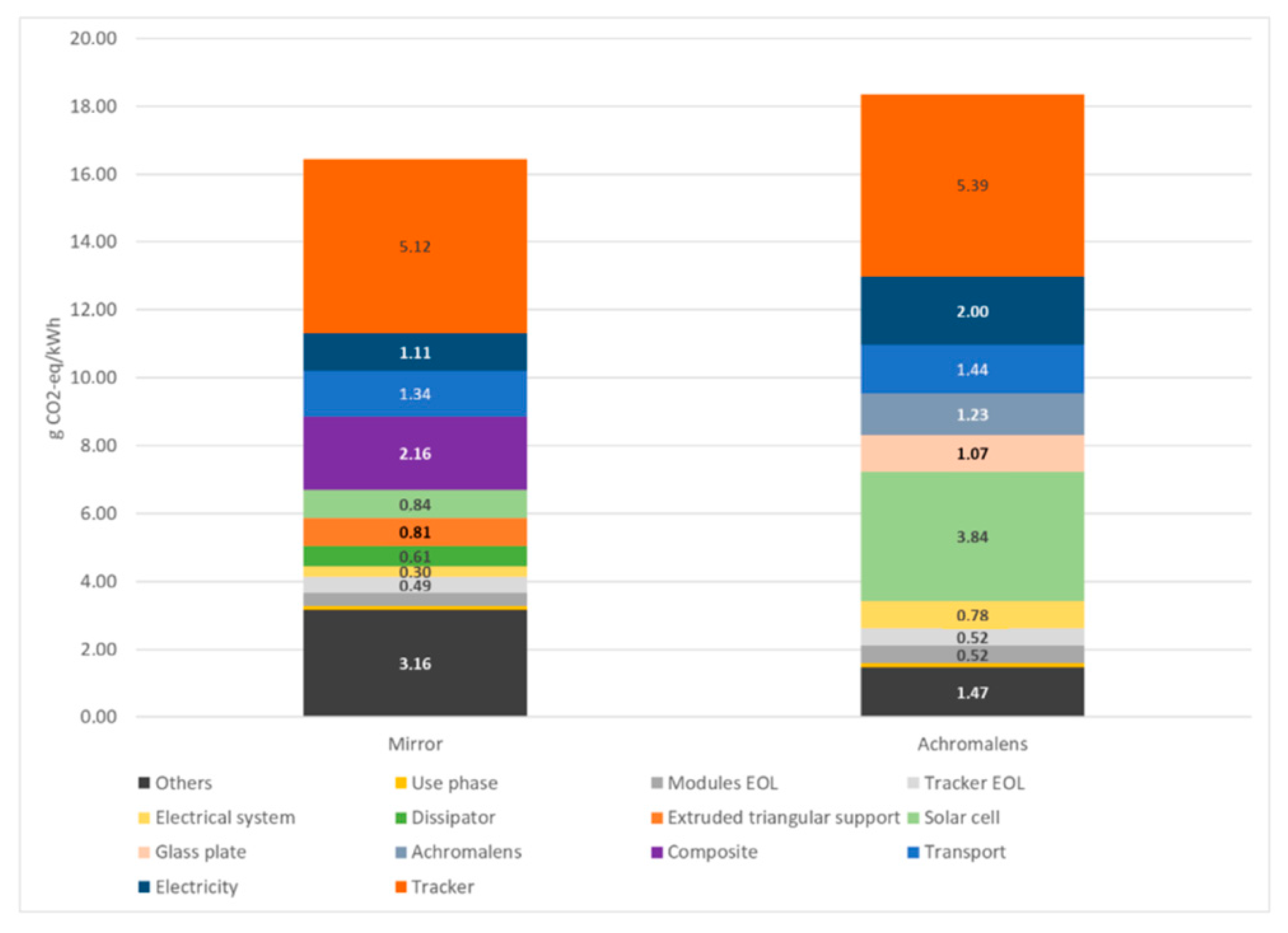
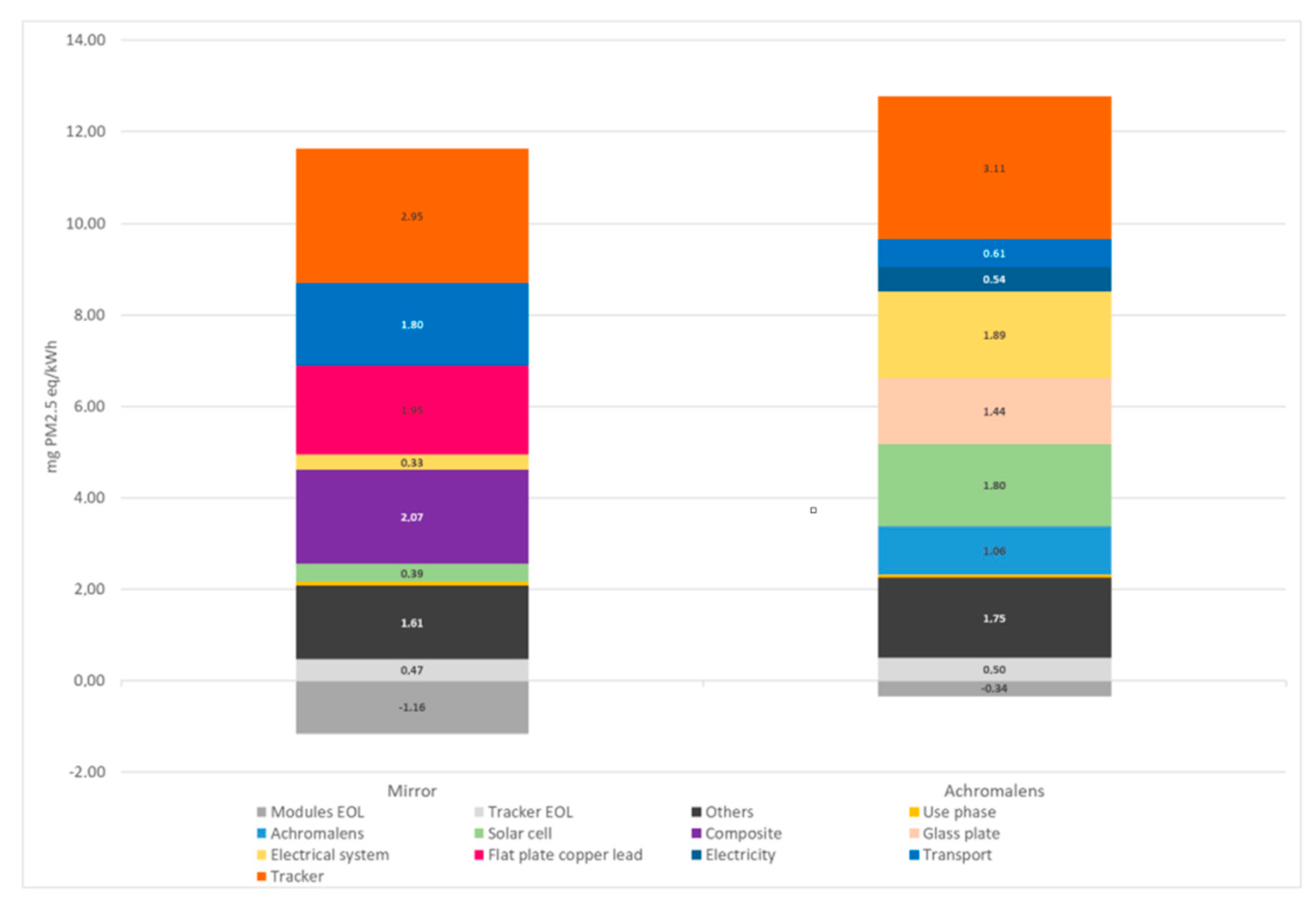
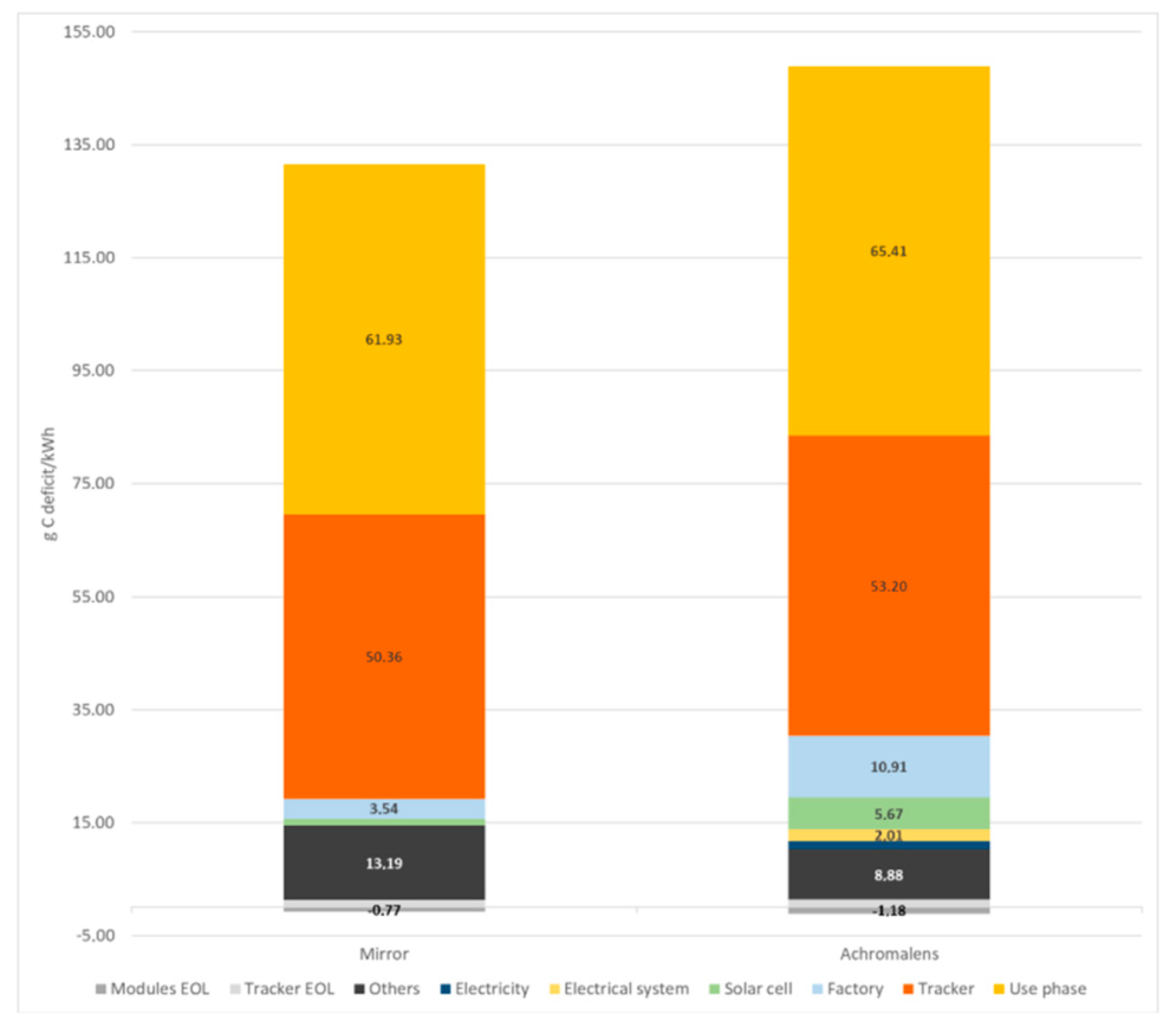
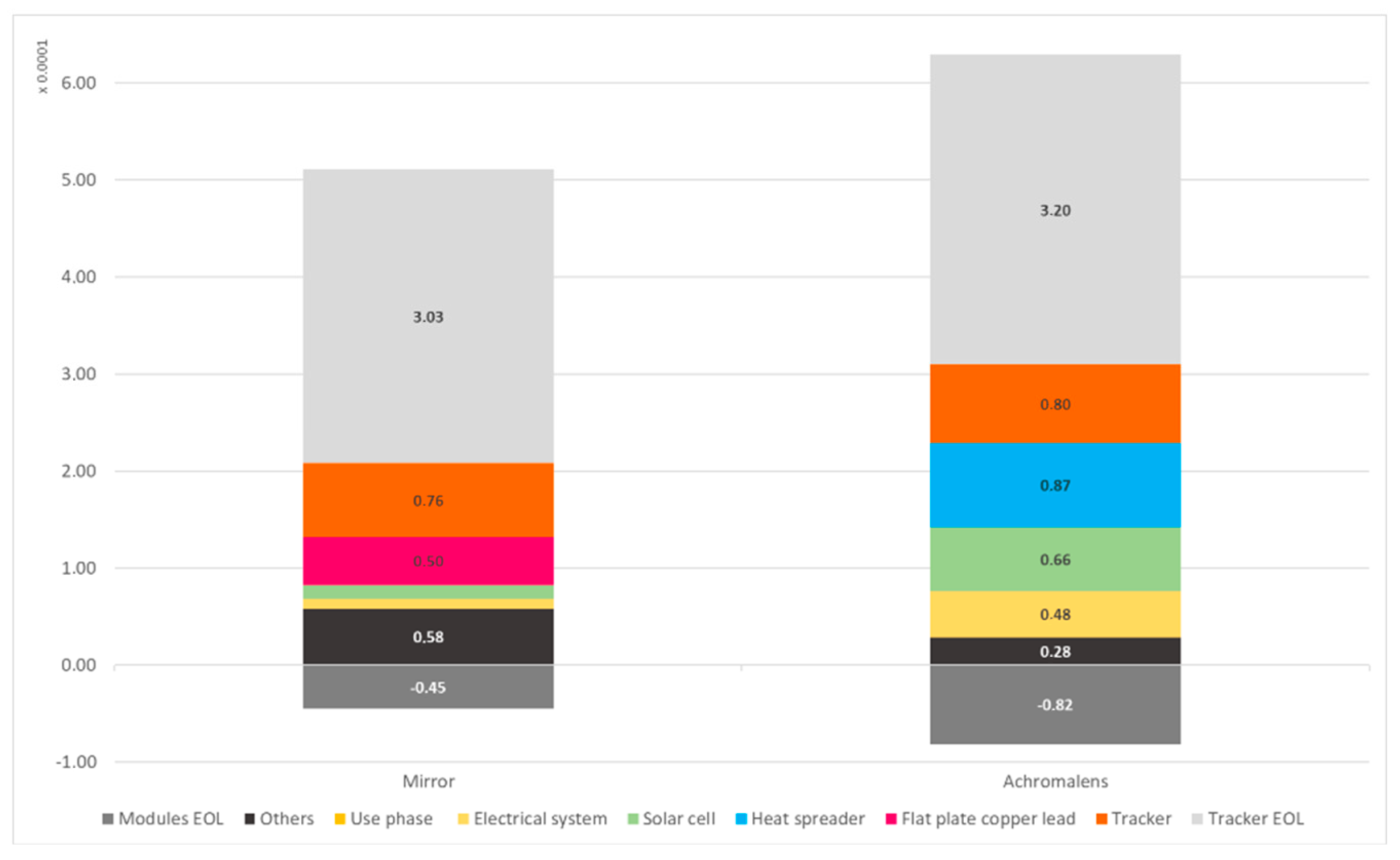

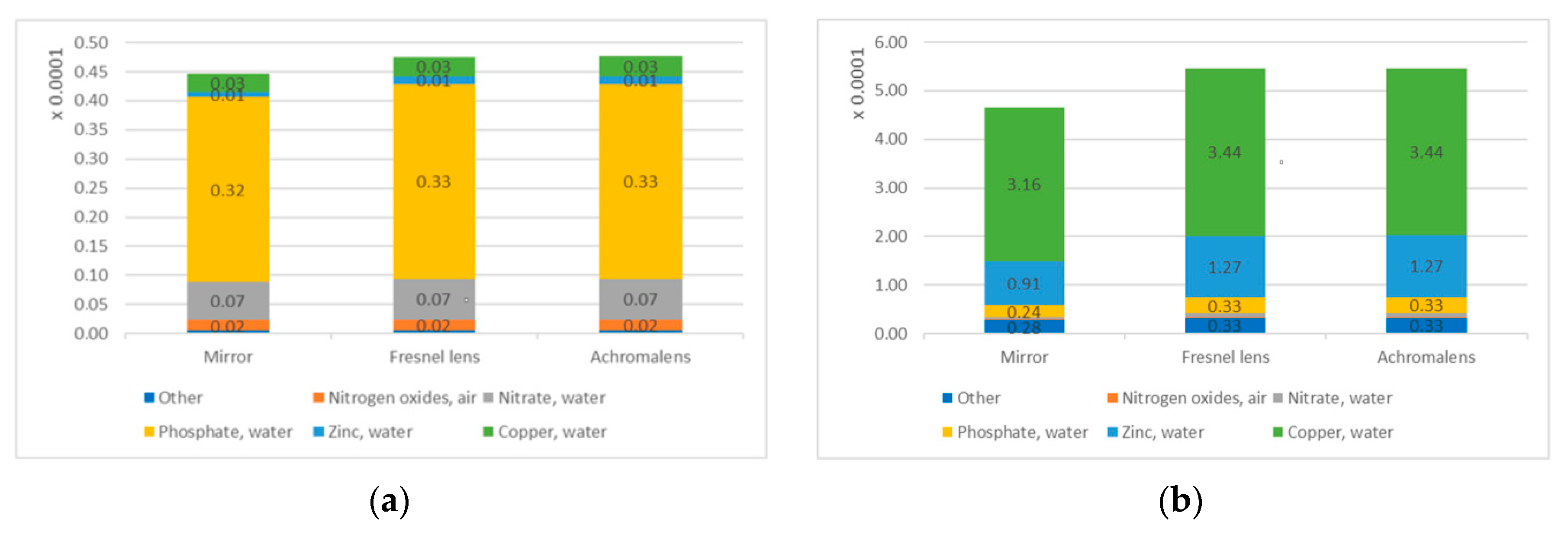
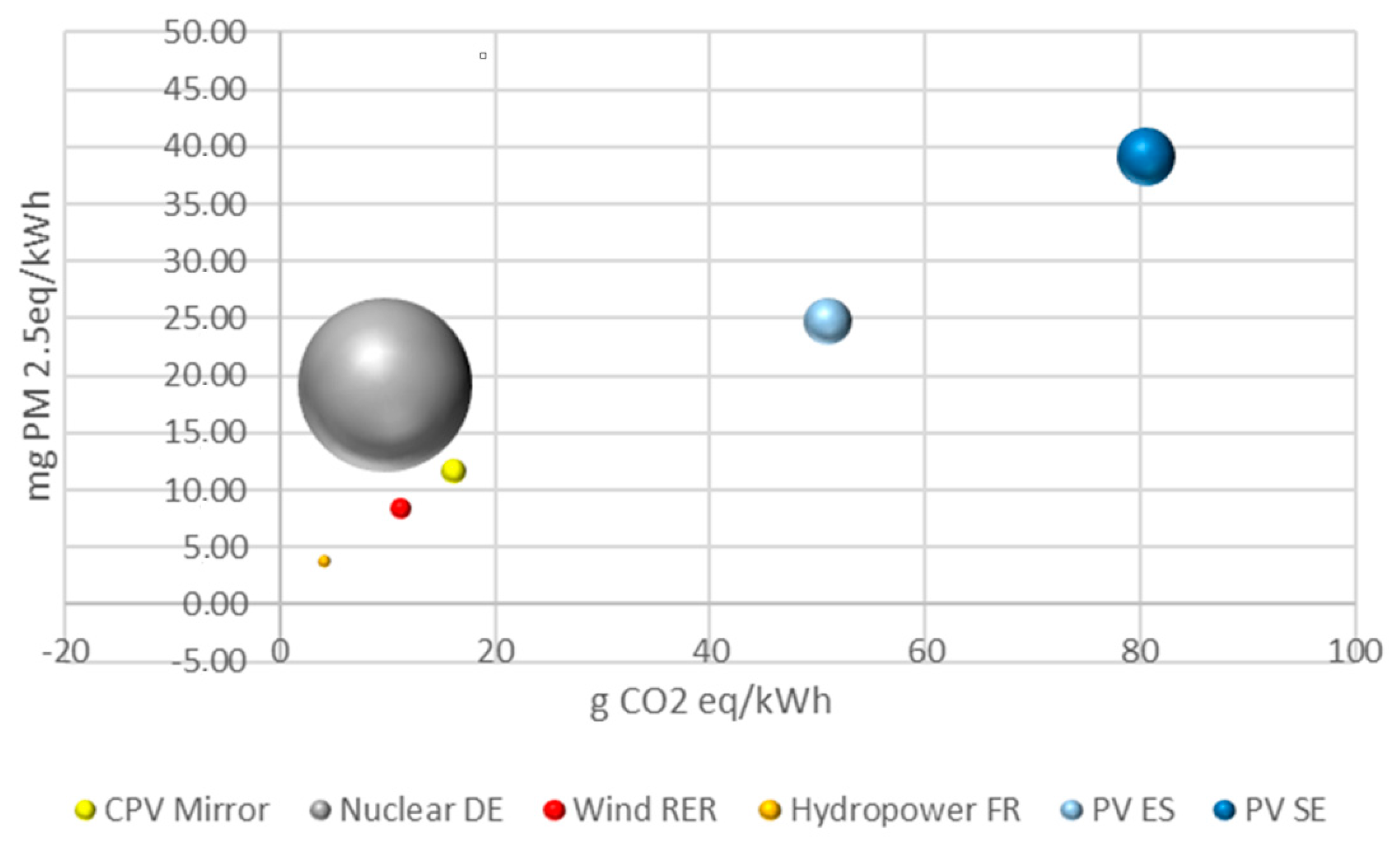
| Scenario | Mirror | Fresnel Lens | Achromalens | |
|---|---|---|---|---|
| Nominal power | Wp | 361.86 | 117.44 | 117.44 |
| Module efficiency | % | 36.7 | 36.7 | 36.7 |
| Concentration ratio | 800 | 320 | 320 | |
| Aperture area | m2 | 0.986 | 0.32 | 0.32 |
| Modules on tracker | Pc | 72 | 210 | 210 |
| Materials | End-of-Life Process Names |
|---|---|
| Electronic components DC-DC converter, printed wiring boards | Disposal, treatment of printed wiring boards/GLO U and Disposal, municipal solid waste, 22.9% water, to sanitary landfill/CH U |
| Glass Glass plate, solar glass | Disposal, glass, 0% water, to inert material landfill/CH U |
| Metals recycled part Copper, gold, silver | Electricity, medium voltage, RER (0.65 kWh/kg) with output material [name of metal], {GLO}| market for | Alloc Def, U |
| Others Silicone product, glass fiber, copper waste, diode, cadmium, butyl acrylate, bisphenol A powder, tetrachlorosilane, epoxy resin | Disposal, municipal solid waste, 22.9% water, to sanitary landfill/CH U |
| Plastics Polycarbonate, Nylon 6-6, vinyl acetate | Disposal, plastics, mixture, 15.3% water, to municipal incineration/CH Uand Steam, in chemical industry {GLO}| market for | Alloc Def, U |
| Solar cell | Hazardous waste, for underground deposit {GLO}| market for | Alloc Def, U |
| Steel | Steel and iron (waste treatment) {GLO}| recycling of steel and iron | Alloc Def, Uand Steel, low-alloyed {GLO}| market for | Alloc Def, U (output to technosphere) |
| Category | Unit | HCPV Mirror | Oil ES | Coal PL | Coal CN |
|---|---|---|---|---|---|
| Climate change | g CO2-eq | 16.4 | 970.9 | 1151.1 | 1409.9 |
| Particulate matter | mg PM2.5-eq | 11.8 | 524.9 | 405.5 | 3320.7 |
| Land use | g C deficit | 131.3 | 3017.2 | 586.5 | 773.4 |
| Non-renewable primary energy demand | MJ | 0.2 | 13.6 | 13.5 | 12.1 |
© 2019 by the authors. Licensee MDPI, Basel, Switzerland. This article is an open access article distributed under the terms and conditions of the Creative Commons Attribution (CC BY) license (http://creativecommons.org/licenses/by/4.0/).
Share and Cite
Payet, J.; Greffe, T. Life Cycle Assessment of New High Concentration Photovoltaic (HCPV) Modules and Multi-Junction Cells. Energies 2019, 12, 2916. https://doi.org/10.3390/en12152916
Payet J, Greffe T. Life Cycle Assessment of New High Concentration Photovoltaic (HCPV) Modules and Multi-Junction Cells. Energies. 2019; 12(15):2916. https://doi.org/10.3390/en12152916
Chicago/Turabian StylePayet, Jérôme, and Titouan Greffe. 2019. "Life Cycle Assessment of New High Concentration Photovoltaic (HCPV) Modules and Multi-Junction Cells" Energies 12, no. 15: 2916. https://doi.org/10.3390/en12152916
APA StylePayet, J., & Greffe, T. (2019). Life Cycle Assessment of New High Concentration Photovoltaic (HCPV) Modules and Multi-Junction Cells. Energies, 12(15), 2916. https://doi.org/10.3390/en12152916



